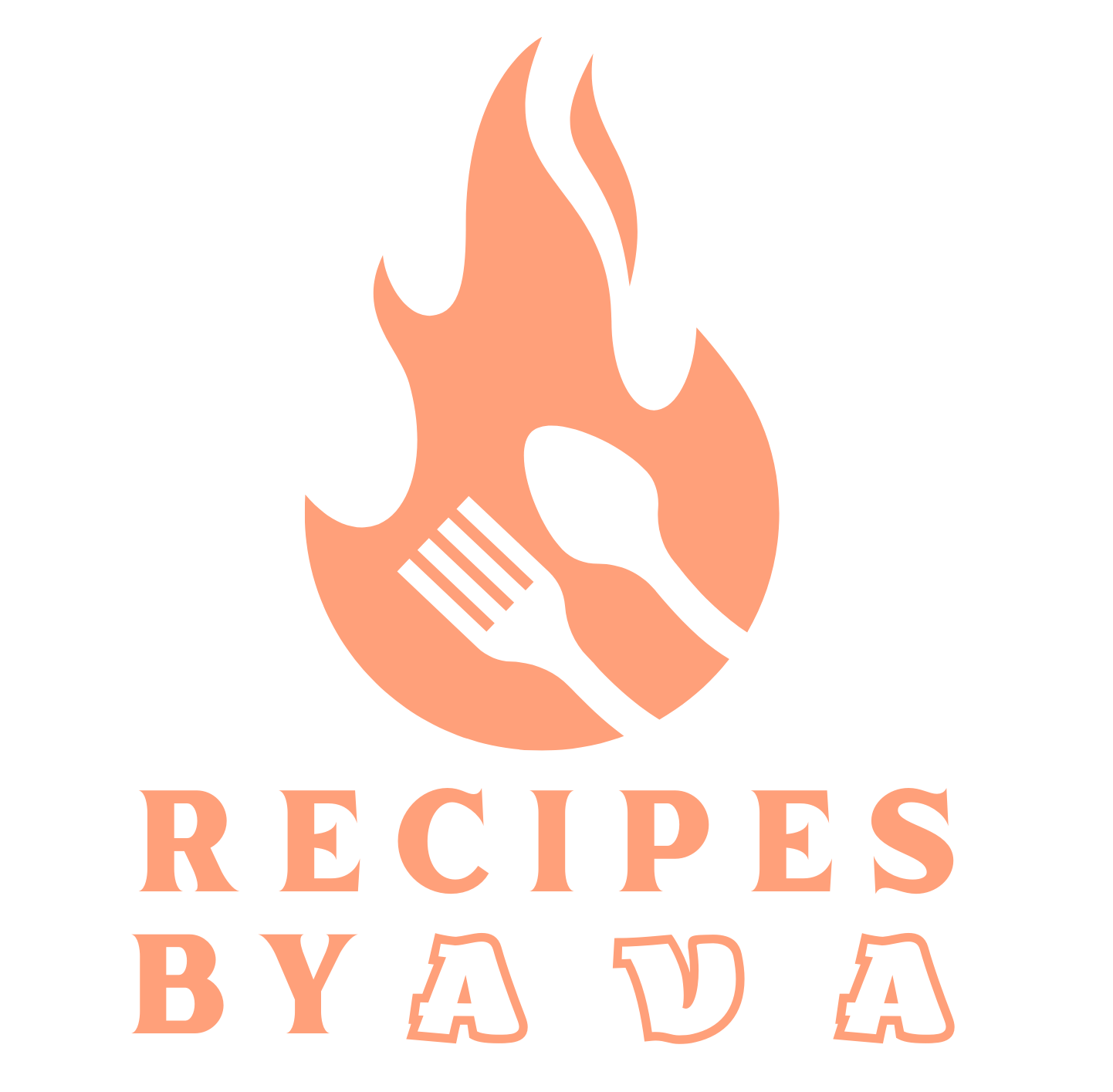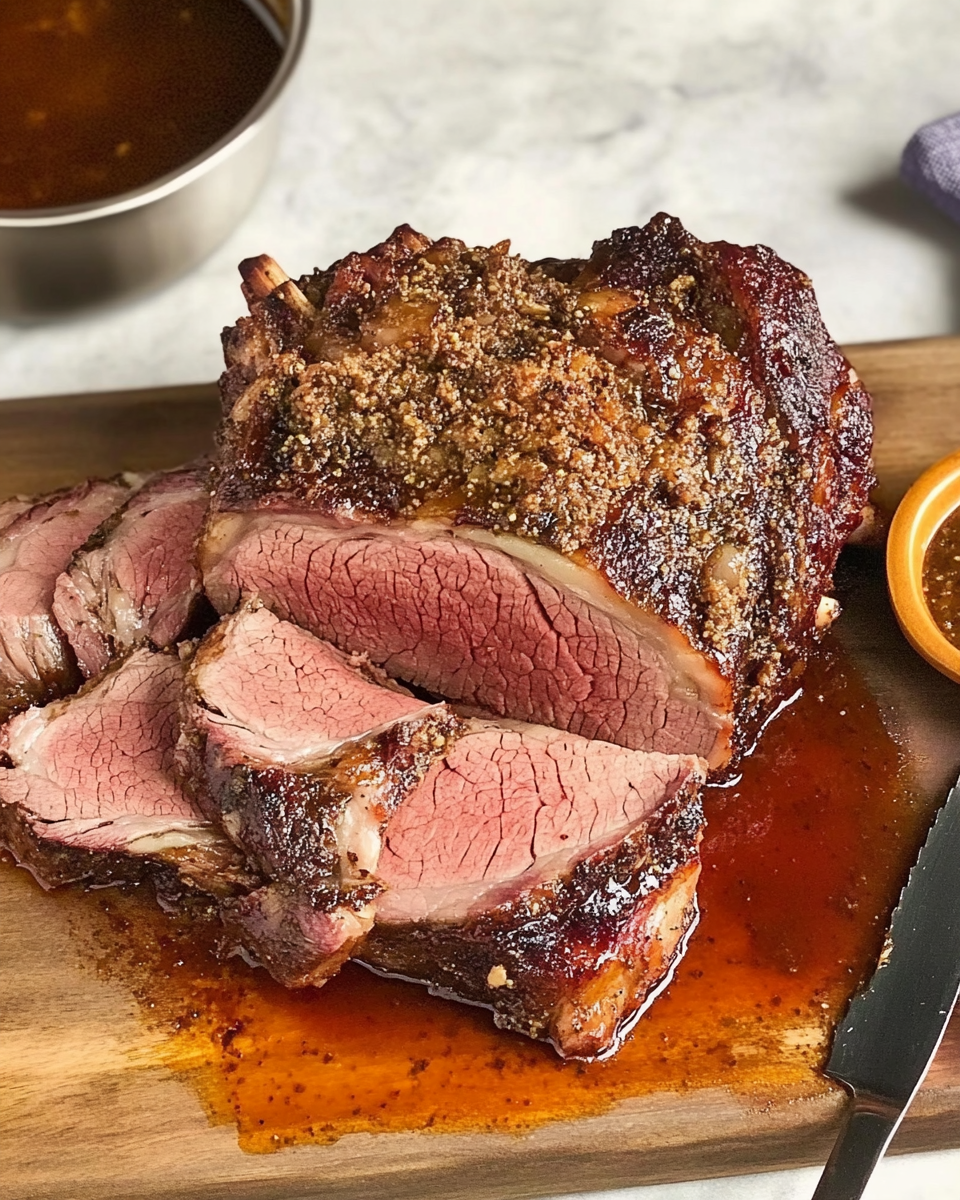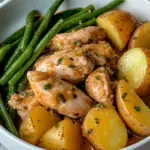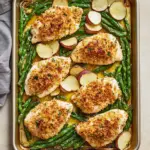This Foolproof Rib Roast is a show-stopping centerpiece that’s perfect for holiday gatherings or special family dinners. Seasoned simply with salt, pepper, and garlic, this roast highlights the rich, natural flavors of prime rib, ensuring a juicy and tender result that’s truly memorable.
The recipe’s simplicity makes it accessible to both new and experienced cooks, as it relies on a unique cooking technique to achieve perfection. The rib roast stands tall on the bone, helping to cook the meat evenly, and the resting period in the oven locks in all the juices, resulting in a beautifully pink and flavorful roast that’s sure to impress everyone around the table.
Full Recipe:
- 1 standing rib roast (4 to 6 pounds), at room temperature
- Salt, to taste
- Freshly ground black pepper, to taste
- Garlic powder, to taste
Directions:
- Preheat your oven to 500°F (260°C).
- Season the roast generously with salt, black pepper, and garlic powder on all sides.
- Place the roast fat side up on a rack in a roasting pan.
- Roast for 1 hour, then turn off the oven. Leave the roast inside without opening the oven door for about 3 hours.
- After 3 hours, turn the oven back on to 500°F (260°C) and cook until the internal temperature reaches at least 145°F (for medium-rare) when checked with an instant-read thermometer.
- Once the desired doneness is reached, remove the roast from the oven, let it rest for 15-20 minutes, then slice and serve.
Prep Time: 10 minutes | Cooking Time: 90 minutes (active) | Total Time: 4 hours 40 minutes Kcal: 450 kcal per serving | Servings: 6-8 servings
Foolproof Rib Roast: A Holiday Classic That Never Fails
A perfectly cooked rib roast is a centerpiece dish that brings an air of sophistication to any dinner table, especially during the holiday season. Known for its tender, juicy texture and richly flavorful meat, this cut has the power to elevate a meal from ordinary to extraordinary. This Foolproof Rib Roast recipe not only guarantees a delicious outcome but also removes the stress often associated with cooking such an impressive piece of meat. Let’s dive into the intricacies of this classic roast, covering everything from choosing the perfect rib cut to suggested accompaniments and storage tips. This guide will help you understand what makes a rib roast so special and how to make it an unforgettable part of your holiday feast.
Understanding the Standing Rib Roast
A standing rib roast, also known as a prime rib roast, is a high-quality cut from the primal rib section of beef. This area contains several of the most flavorful and tender muscles, which is why prime rib is considered one of the finest cuts. When cooked properly, this cut offers a blend of tenderness, juiciness, and deep flavor, making it a prized centerpiece for festive gatherings. It’s called a “standing rib roast” because it’s typically cooked “standing” on the rib bones, which helps the meat cook more evenly and keeps it elevated away from the pan’s juices.
Prime rib roasts are available in several different grades, including Choice and Prime. The Prime grade, while often more expensive, is marbled with fat, which adds flavor and tenderness as it melts during cooking. For those who prefer a slightly leaner cut without sacrificing too much flavor, Choice is a fantastic option that tends to be more budget-friendly.
Why This Recipe Works
This Foolproof Rib Roast recipe simplifies the cooking process with a unique approach: after an initial roast in a high-temperature oven, the heat is turned off, allowing the roast to continue cooking in residual heat. This technique minimizes the risk of overcooking and maintains the ideal texture and flavor. For many, cooking a rib roast can be intimidating, as it’s an expensive cut and the cooking time can vary based on the thickness and size of the roast. This method, however, brings consistency to the results, ensuring that the meat cooks evenly without requiring constant checking.
Another standout feature of this recipe is its minimal seasoning. Rather than using a complex blend of spices, the roast is seasoned simply with salt, pepper, and garlic powder. This allows the natural flavor of the meat to shine through, delivering a pure beefy taste that doesn’t need much embellishment. Some seasoned cooks might choose to add additional herbs like rosemary or thyme, or a sprinkle of Montreal steak seasoning, but the simplicity of salt and pepper is often all that’s needed to create a standout dish.
Choosing the Right Roast Size
The size of your rib roast will depend on the number of guests you’re serving. A general rule of thumb is to allow for about 1 pound of bone-in roast per person. If you’re purchasing a boneless version, plan for around 3/4 pound per person. Rib roasts can come with different numbers of ribs, often ranging from two ribs (suitable for two to four people) to seven ribs (which can serve 10 or more). Choosing the right size ensures you’ll have enough to go around and potentially a few leftovers to enjoy the next day.
If you’re hosting a large gathering, it may be worth considering two smaller roasts instead of a single large one. This way, you can cook each roast to a different level of doneness to accommodate various preferences, or keep one warm while the other is served.
Cooking Techniques for Prime Rib
The oven-off technique used in this recipe leverages residual heat, allowing the roast to cook gently and evenly without constant attention. To begin, the oven is preheated to a high temperature (usually 500°F or 260°C), which sears the roast’s exterior and locks in moisture. After an hour of cooking, the oven is turned off, and the roast is left to continue cooking in the trapped heat. It’s essential to resist the urge to open the oven door during this time, as this would let the heat escape, slowing down the cooking process.
When the cooking time has elapsed, the oven is turned back on to finish the roast and bring it up to the desired internal temperature. The USDA recommends an internal temperature of 145°F for medium-rare, which provides a juicy, pink center. For those who prefer medium, a temperature of 160°F works well.
An instant-read thermometer is a valuable tool to ensure the roast reaches the perfect doneness. Insert it into the thickest part of the meat, away from the bone, to get an accurate reading. After removing the roast from the oven, allow it to rest for 15-20 minutes before carving. This resting period allows the juices to redistribute within the meat, ensuring each slice is tender and juicy.
Suggested Sides and Pairings
A rib roast pairs wonderfully with classic sides that complement its richness and flavor. Some popular options include:
- Gourmet Mushroom Risotto: The earthy flavors of mushrooms and the creamy texture of risotto are a perfect match for the robust taste of rib roast.
- Mashed Potatoes with Mascarpone: Smooth and creamy mashed potatoes with a hint of mascarpone add a luxurious touch, balancing the meat’s intensity.
- Truffled Cauliflower Gratin: The subtle hint of truffle adds an elegant, savory note, while the gratin’s creamy texture is a delightful contrast to the juicy roast.
- Oven-Roasted Carrots: Sweet, caramelized carrots add both color and flavor, offering a touch of sweetness that complements the savory roast.
- Fried Brussels Sprouts: A bit of crispiness and a hint of bitterness from fried Brussels sprouts provide a refreshing balance to the meat’s richness.
A robust red wine, such as Cabernet Sauvignon, Syrah, or Merlot, pairs beautifully with a rib roast, enhancing its flavors and creating a cohesive dining experience.
Storing and Reheating Leftovers
Rib roast is a dish that can be just as delicious the next day if stored and reheated properly. Leftover roast should be wrapped tightly in plastic wrap or foil and stored in the refrigerator for up to five days. For longer storage, rib roast can be frozen. To freeze, slice the roast into desired portions, wrap each piece in freezer wrap followed by a layer of aluminum foil, and place them in an airtight freezer bag. Rib roast can be frozen for up to nine months without losing quality.
To reheat, avoid the microwave as it can make the meat rubbery. Instead, wrap the roast in foil and place it in an oven set to a low temperature (around 300°F or 150°C) until it is warmed through. This gentle reheating method maintains the meat’s tenderness and flavor.
Conclusion
This Foolproof Rib Roast recipe takes the guesswork out of preparing a prime rib and delivers a reliable, mouthwatering result. By following a simple yet effective cooking technique, even beginners can achieve a roast with a perfectly seared crust and a tender, juicy interior. The recipe’s minimal seasoning highlights the natural flavors of the beef, allowing it to shine without overpowering the palate.
Whether you’re hosting a holiday gathering or preparing a special family dinner, this rib roast recipe promises an impressive presentation and a delightful dining experience. Paired with classic side dishes and a bold red wine, this roast creates a meal that’s both comforting and elegant. The leftovers, if any remain, can be enjoyed over the next few days, ensuring that the effort put into this dish continues to pay off.
A Foolproof Rib Roast is more than just a main course; it’s a memorable dish that brings people together, enhances holiday traditions, and creates lasting memories around the table. With this recipe, you’ll not only master the art of cooking a rib roast but also add a timeless, crowd-pleasing recipe to your collection.






